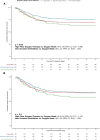Non-invasive oxygenation support in acutely hypoxemic COVID-19 patients admitted to the ICU: a multicenter observational retrospective study
- PMID: 35135588
- PMCID: PMC8822661
- DOI: 10.1186/s13054-022-03905-5
Non-invasive oxygenation support in acutely hypoxemic COVID-19 patients admitted to the ICU: a multicenter observational retrospective study
Abstract
Background: Non-invasive oxygenation strategies have a prominent role in the treatment of acute hypoxemic respiratory failure during the coronavirus disease 2019 (COVID-19). While the efficacy of these therapies has been studied in hospitalized patients with COVID-19, the clinical outcomes associated with oxygen masks, high-flow oxygen therapy by nasal cannula and non-invasive mechanical ventilation in critically ill intensive care unit (ICU) patients remain unclear.
Methods: In this retrospective study, we used the best of nine covariate balancing algorithms on all baseline covariates in critically ill COVID-19 patients supported with > 10 L of supplemental oxygen at one of the 26 participating ICUs in Catalonia, Spain, between March 14 and April 15, 2020.
Results: Of the 1093 non-invasively oxygenated patients at ICU admission treated with one of the three stand-alone non-invasive oxygenation strategies, 897 (82%) required endotracheal intubation and 310 (28%) died during the ICU stay. High-flow oxygen therapy by nasal cannula (n = 439) and non-invasive mechanical ventilation (n = 101) were associated with a lower rate of endotracheal intubation (70% and 88%, respectively) than oxygen masks (n = 553 and 91% intubated), p < 0.001. Compared to oxygen masks, high-flow oxygen therapy by nasal cannula was associated with lower ICU mortality (hazard ratio 0.75 [95% CI 0.58-0.98), and the hazard ratio for ICU mortality was 1.21 [95% CI 0.80-1.83] for non-invasive mechanical ventilation.
Conclusion: In critically ill COVID-19 ICU patients and, in the absence of conclusive data, high-flow oxygen therapy by nasal cannula may be the approach of choice as the primary non-invasive oxygenation support strategy.
Keywords: Acute hypoxemic respiratory failure; COVID-19; Intensive care; Non-invasive oxygenation.
© 2022. The Author(s).
Conflict of interest statement
P.D Wendel-Garcia has nothing to disclose. A. Mas declares teaching fees from Fundació Parc Tauli, outside the submitted work. C. González-Isern has nothing to disclose. R. Ferrer declares personal fees from MSD, GSK, Alexion, Pfizer, Shionogi, Menarini and Gilead, outside the submitted work. R. Máñez has nothing to disclose. J.R. Masclans declares grants and research support from Fisher&Paykel and fees from Dextro payed to his Institution, outside the submitted work. E. Sandoval, P. Vera, J. Trenado, R. Fernández, J.M. Sirvent, M. Martínez, M. Ibarz, P. Garro, J.L. Lopera, M. Bodí, J.C. Yébenes-Reyes, C. Triginer, I. Vallverdú, A. Baró, F. Bodí, P. Saludes, M. Valencia, F. Roche-Campo, A. Huerta, F.J. Cambra, C. Barberá, J. Echeverria, and O. Peñuelas have nothing to disclose. J. Mancebo declares personal fees from Medtronic and Janssen, a research grant from Covidien/Medtronic and the Canadian Institutes of Health Research and he is consultant for Vyaire, all outside the submitted work.
Figures



References
-
- Wendel Garcia PD, Fumeaux T, Guerci P, Heuberger DM, Montomoli J, Roche-Campo F, et al. Prognostic factors associated with mortality risk and disease progression in 639 critically ill patients with COVID-19 in Europe: Initial report of the international RISC-19-ICU prospective observational cohort. EClinicalMedicine. 2020;25:100449. - PMC - PubMed
Publication types
MeSH terms
LinkOut - more resources
Full Text Sources
Medical
Miscellaneous

